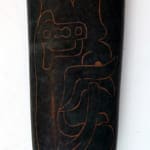Akan Gold Nugget and Venetian Glass Trade Bead Necklace, 18th Century CE - 19th Century CE
Gold and Glass
FJ.7260
This necklace combines genuine Venetian glass trade beads found in Africa with gold nugget beads from the Akan tribe. In many cultures throughout the world, gold has been associated with...
This necklace combines genuine Venetian glass trade beads found in Africa with gold nugget beads from the Akan tribe.
In many cultures throughout the world, gold has been associated with status, power, prestige and wealth. As early as the 15th century, European merchants wrote about the richness of African gold objects used for adornment and intended for public display. Gold deposits were discovered in all regions of Africa, and became the most important commodity during pre- colonial times. The region of the Akan, spreading from the forest zone and costal areas of Ghana to the southern shores of the Ivory Coast, is the richest auriferous zone in West Africa. Several individual tribes make up the Akan people, the Asante and Baule being among the most famous, all united by their common ancestry and language. The royal courts of the Akan people were reportedly the most splendid in Africa. Oral tradition and iconography in Akan works of art are very closely connected. Verbal and visual symbolism tells stories or proverbs. Imagery of royal power on court ornaments carry out messages that helps keep the balance and continuity within the society.
During the late Middle Ages and throughout the Renaissance, Venetian artisans rediscovered the ancient secrets of glass making. On the island of Murano, they created superb vessels and jewelry which were valued throughout the known world. It was also during this period that Venice became the most powerful trading nation in Europe, a city whose ships visited every port both east and west. Venetian traders used glass beads for barter, and these jewels became especially prized in Africa, where they were traded for gold, ivory, rare woods and spices. Venetian beads quickly became a medium of exchange throughout Africa, and in some tribes were used as a bridal dowry.
In many cultures throughout the world, gold has been associated with status, power, prestige and wealth. As early as the 15th century, European merchants wrote about the richness of African gold objects used for adornment and intended for public display. Gold deposits were discovered in all regions of Africa, and became the most important commodity during pre- colonial times. The region of the Akan, spreading from the forest zone and costal areas of Ghana to the southern shores of the Ivory Coast, is the richest auriferous zone in West Africa. Several individual tribes make up the Akan people, the Asante and Baule being among the most famous, all united by their common ancestry and language. The royal courts of the Akan people were reportedly the most splendid in Africa. Oral tradition and iconography in Akan works of art are very closely connected. Verbal and visual symbolism tells stories or proverbs. Imagery of royal power on court ornaments carry out messages that helps keep the balance and continuity within the society.
During the late Middle Ages and throughout the Renaissance, Venetian artisans rediscovered the ancient secrets of glass making. On the island of Murano, they created superb vessels and jewelry which were valued throughout the known world. It was also during this period that Venice became the most powerful trading nation in Europe, a city whose ships visited every port both east and west. Venetian traders used glass beads for barter, and these jewels became especially prized in Africa, where they were traded for gold, ivory, rare woods and spices. Venetian beads quickly became a medium of exchange throughout Africa, and in some tribes were used as a bridal dowry.



